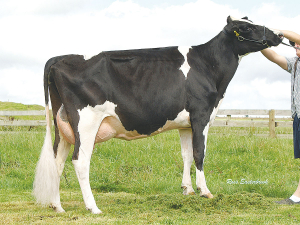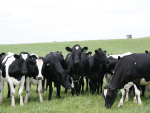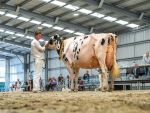Shelley Schnuriger’s resolve to reduce their Holstein Friesian herd to 100 cows has proven its worth, with an exceptional per-cow production backing up their decision.
In doing so, they had the opportunity to feed their cows substantially better, and as a result, they are estimated to produce a total of 64,000- 65,000 kgMS on a predominantly pastureb-ased system, with some in-shed feeding and grass silage.
Pat grew up on a dairy farm with his parents, which is how his passion for milking cows began. As an adult, he worked through the contract to share milking system before finally purchasing the Waikite Valley farm in 2001.
Shelley’s passion for farming stemmed from growing up on a sheep and beef farm, and then the dairy farm her parents sharemilked on.
The Raetea stud was first established around 16 years ago when Shelley bought her first show cow, Tahora Nelson Lark VG85, from the Tahora Topshelf Sale.
Shelley always loved the idea of showing cattle after helping her friends show their Brown Swiss cows.
“I always had the idea I wanted to get into showing cows myself,” she says. “I had an eye for Holstein Friesian cows, and so my dad helped me buy a couple of Holsteins. I really didn’t have anywhere to put them because I didn’t own a farm.”
Pat and Shelley met 14 years ago, when Shelley was looking for someone to take care of her cows. Shelley was encouraged by friends to ask Pat to do so, and the rest is history.
Once Shelley’s Holsteins arrived on the farm, they made their way into Pat’s crossbred/Holstein Friesian herd.
“I changed Pat’s outlook on pedigree Holsteins and what they’re capable of,” Shelley says. “That’s how our stud has evolved over the years; because of my passion for showing these pedigree cows.”
The first cow Pat and Shelley bought together was Fantastic Lartst Like S2F EX4, purchased from the 2011 Waipa Club sale.
“She has been a massive foundation cow in our herd,” Shelley says. “We bought her as a rising three-year-old and showed her until she was nine or ten. She won many of the local championship shows, and she passed away at fourteen years old.”
The Schnurigers are still showing her daughters and granddaughters, and all the cows from this line have proved to be fantastic show cows.
Another one of Pat and Shelley’s foundation cows was Happyland Breanna S3F VG88 5*, purchased from a local breeders Rachel and Andrew Burke.
Breanna was sired by Comestar Leader, and her best production was as an 11-year-old when she milked for 265 days, producing 8830 litres of milk (421kg fat, 314kg protein).
“She has been another significant cow in our herd, particularly for breeding,” Shelley says. “Her family line has had a big influence on our herd.”
Breanna has had six Raetea heifers, and four of these have classified above VG85.
Raetea Shot Jessie J VG89 1* SP is a current stand-out producer in the Raetea herd. Jessie is sired by Lincoln-Hill Shot Laser-ET, and her best production was as a seven-year-old when she milked for 305 days and produced 11,251 litres of milk (501kg fat, 388kg protein).
As a result of their exceptional per-cow production, the Schnurigers have received the Nutritech Performance Award (for Ward 3, Bay of Plenty) for five years in a row at the annual Holstein Friesian NZ Awards.
Over the last few years, Pat and Shelley have altered their mating process significantly.
“Our empty rate was getting worse and worse and no matter what we did, it didn’t get any better,” Pat says. “We noticed that it was the same cows returning; we were essentially wasting semen.
“These cows were often our overseas-bred animals, and we have found that we can milk them through winter empty and get a second lactation from them. These cows often milk just as well, if not better than they did when they were freshly calved.
“So, we have reduced our workload by only doing seven weeks of AI, and no bulls. We saw no change in our empty rate, and we now have only seven weeks of calving.”
They milk twenty cows over winter and still send milk, but through June they put these cows on once-a-day.
“We start calving on July 1 and dry off around mid-May, so it’s only about five weeks between dry-off and calving,” Pat says. “We try to get 305 days in milk from all of our cows.”
No 'Blanket Bull'
Pat and Shelley Schnuriger don’t “blanket bull” their herd, they look at “each and every one” of their cows.
They look at their TOP scores and consider which traits need to be improved on each cow, and then look at which bulls will fit what they want to improve, production being their top priority.
“Sometimes we pick 10-15 bulls for the entire herd,” Shelley says. “We couldn’t do this if we had a bigger herd; it would take forever. At the moment, our biggest problem is finding bulls that are good enough to meet our criteria.
“Although, we are happy with a bull called Barolo. His calves are quite nice show types, and we are excited to start milking about five of them this coming spring.”
Claynook Barolo SG has a fat BV 52, a protein BV 34 and an udder overall 1.89.
“We are starting to use polled genetics, and so that makes it a struggle to find bulls who are polled and good enough to use,” Shelley says.


















